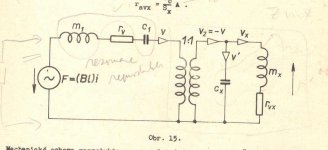john curl said:Much of the research has been done originally by Otala, dismissed by Cordell, and shunned by the AES. You are too late Joshua_G, you have to look back at the OLD knowledge of 30 years ago.
I did not dismiss any of Otala's IIM work. Most of it was good stuff. I simply DISPROVED one of his assertions/conclusions, i.e., that high open-loop output impedance reduced by negative feedback leads to IIM.
Otala did a lot of good work, but he shot himself in the foot by drawing wrong conclusions from some of that work. He had a serious blind spot when it came to scientific discipline in drawing conclusions and testing them.
Cheers,
Bob
janneman said:
A dummy load of say, 4 ohms with a phase shift above some frequency of, say, 45 degrees suggests itself as a kind of worst-case speaker, no?
Jan Didden
Make it 3 times, add crossover and let it dip to 1-2 ohm at 200-300Hz, then maybe, and not all cases.
john curl said:Joshua_G, you are going to run up against a 'dead end'. This is because the 'models' are only partial, and they won't show you much. Of course, a PURE inductance or capacitance will make almost any amp cry for help, but you can't model everything in between. We, real amp designers, have addressed this for decades. The biggest problems are protection circuitry firing too often, current limiting, and breakdown because of operation in a forbidden region.
I know that such models are only partial, at best.
That's why I'm not going to rely on such model – I only asked those who suggested it about a working one.
SY said:
Look up "reactance."
Reactance wouldn't emulate the stored acoustic energy, turned to electrical energy, that happens in speakers.
Edmond Stuart said:Huh? 0.5Ohm? The guy who made this speaker surely hates amplifier designers.
The purpose of a speaker is to reproduce sound, not to 'play nice' with amplifiers
PMA said:
Make it 3 times, add crossover and let it dip to 1-2 ohm at 200-300Hz, then maybe, and not all cases.
Even then, the stored acoustic energy, turned to electrical energy wouldn't be accounted for.
Bob Cordell said:
Hi John,
You are quite correct about the loudspeaker and how it acts. Indeed, I covered this in detail in my IIM paper long ago - using SPICE to model the loudspeaker, no less. The high currents that can be generated under certain conditions are real. We don't disagree on this.
Where we do disagree is in regard to the correction signal that is required to keep the output node from wiggling in response. That signal going back does not create a problem, at least insofar as Otala's definition and measurement method for IIM. I have measured real amplifiers for IIM and also shown theoretically that IIM does not increase when the NFB is responsible for the low closed-loop output impedance. I think your intuition is just getting the best of you here.
Did you measure that amplifier with a real speaker?
Joshua_G said:
Even then, the stored acoustic energy, turned to electrical energy wouldn't be accounted for.
Popular misunderstanding of people out of the field. Electro-mechanical-acoustical elements are transformed to electrical side of the circuit as a parallel resonant circuit, that covers energy exchange.
PMA said:
Popular misunderstanding of people out of the field. Electro-mechanical-acoustical elements are transformed to electrical side of the circuit as a parallel resonant circuit, that covers energy exchange.
How do you simulate such parallel resonant circuit that will conform with what actually goes on in real speakers?
PMA said:Look Joshua, it is like this. But engineers graduated in electro-acoustics are not welcome in this thread. Electro-mechanical transformation. Mass to inductance, compliance to capacitance, friction to resistivity.
What speaker this circuit represents?
myhrrhleine said:The purpose of a speaker is to reproduce sound, not to 'play nice' with amplifiers
Sure! But torturing amps with 0.5 Ohm is unnecessary bad practice.
Electrodynamic speaker in a bass-reflex box (vented box). The values according actual speaker and box and vent.
Don't forget we speak mechanical right now.
It is really difficult to communicate this way.
Then, gyrator transfers to el. circuit like
http://sound.westhost.com/tsp.htm
Don't forget we speak mechanical right now.
It is really difficult to communicate this way.
Then, gyrator transfers to el. circuit like
http://sound.westhost.com/tsp.htm
Joshua_G said:Reactance wouldn't emulate the stored acoustic energy, turned to electrical energy, that happens in speakers.
Is that so?

PS: Any mechanical (resonant) system has an electrical analogue.
PMA said:
Popular misunderstanding of people out of the field. Electro-mechanical-acoustical elements are transformed to electrical side of the circuit as a parallel resonant circuit, that covers energy exchange.
Pure delay, reflections, and other non-minimum phase behavior are harder to include. I'm with SY on the Klipsh

- Status
- Not open for further replies.
- Home
- Amplifiers
- Solid State
- John Curl's Blowtorch preamplifier
